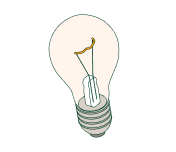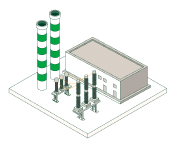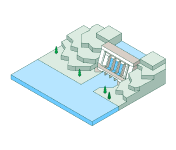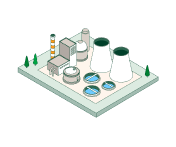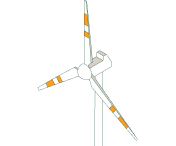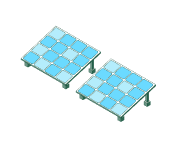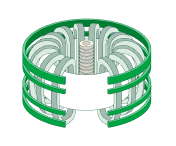History of electricity
150 years on the path towards sustainability: history of electricity
Thomas Edison's first electric power plant built in 1882 only supplied current to a few light bulbs. Since then, the grid that carries electricity to our homes has expanded and is facing the biggest challenge so far: to become completely fossil-fuel free and move towards renewable energy sources. Discover the history of electricity until nowadays.
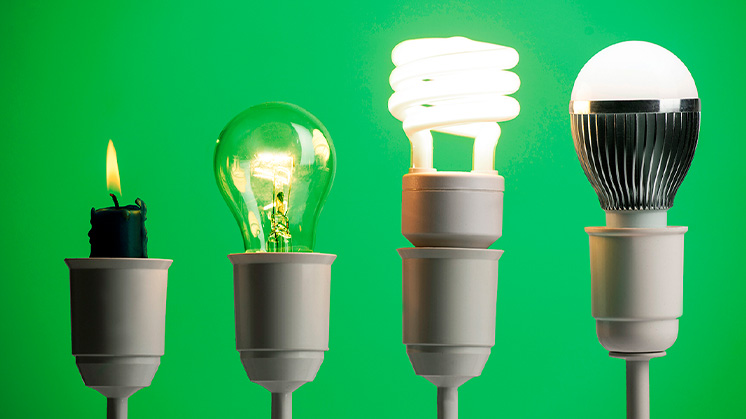
The history of electricity is a tale of successive discoveries and advances. Each chapter of this history helps us to understand how this invention has been one of the great driving forces behind the modernisation of humanity. From the first experiments by pioneering scientists, such as Benjamin Franklin and Alessandro Volta, to the consolidation of the theories of electricity in the hands of Michael Faraday and Thomas Edison. The appearance of the electric lightbulb in the 19th century ushered in an era that radically transformed everyday life – marking a fundamental milestone in the progress towards the world we know today.
Origin and history of electricity
As we know, electricity and light work together. But, in opposition to what has been popularly established, the inventor of electricity was not Edison. Nor was the first to patent the incandescent light bulb. Other inventors had already invented it a decade earlier, but his invention was the only one that became commercially viable. After obtaining the patent in 1879, he established the Edison Illuminating Company and opened the first electric power plant in 1882 to market electric energy to the people who bought his light bulbs.
He started with 80 customers and 400 light bulbs, but his business grew to over 500 customers — including The New York Times — and 10,000 light bulbs in only two years. In addition to becoming the first electric power plant, it was also the first cogeneration plant, since the steam was used to heat adjoining buildings. That same year, H. J. Rogers, a paper manufacturer, built the first hydroelectric power plant on Fox River (Wisconsin, United States).
During the turn of the century, interest in harnessing rivers and lakes as key resources for the production of hydroelectric power intensified. It was at this time that hydroelectric power plants emerged as alternative sources of energy production, coinciding with the increase in demand for electricity in major urban centres. Numerous dams and small power plants were built in Europe and the United States during this period, driven by rapid industrial development.
In 1900, for example, 40% of US electricity came from hydroelectric power plants. In 1940 it was 30%, and today it is only 6.23 %. In Europe, one of the first plants built was Jaruga in Croatia, which began supplying power to the nearby town of Sibenik in 1895 with a power of 235 kW, and remained in service until the First World War. Simultaneously, in Australia, the Duck Reach power station in the town of Launceston (Tasmania) was opened as the first publicly-owned hydroelectric facility in the southern hemisphere.
These first electric power plants operated with direct current, which prevented electricity from being carried over long distances. It was another genius who solved this problem: Nicola Tesla and his commitment to use alternating current. In 1895, he built the hydroelectric power plant in Niagara Falls with industrialist George Westinghouse, carrying electricity to Buffalo, which was 40 kilometres away. The electrification of the world had started and, with this, the second industrial revolution.
Two new projects drove this process in 1898: the Decew Falls hydroelectric power plant in Ontario (Canada) was the first to generate high-voltage electricity in the world, which would be transported over long distances; the power plant in Rheinfelden (Germany) was the first to use 50 Hz three-phase alternative current, today's standard almost everywhere around the globe.
In 1951, the first experimental nuclear power plant was opened in Ohio (United States) – marking a milestone in the search for new sources of energy. During the 20th century, fossil fuels and nuclear power plants replaced water to generate energy throughout the world. What is the challenge of the 21st century? Without a doubt, to replace these with more sources of renewable energy.
History of electricity
- 1879
- 1880
- 1882
- 1895
- 1951
- 1956
- 1959
- 1965
- 2020
- 20??
Source: IEEE (Institute of Electrical and Electronic Engineers).
 SEE INFOGRAPHIC: a brief history of electricity [PDF] External link, opens in new window.
SEE INFOGRAPHIC: a brief history of electricity [PDF] External link, opens in new window.
When did clean energy start to be produced?
Over the years, innovation and technological advances have driven the search for more sustainable energy alternatives, ushering in the production of clean energy. The idea of concentrating sunbeams to use their heat comes from ancient Greece, but Frank Shuman was a pioneer and the first one to market this as a commercially viable solution. He established the Sun Power Co. in 1911, building the first solar farm in Tancony (United States). However, his biggest project, cut short by the First World War, was a 52,000 km2 solar farm in Sahara desert, which would generate enough energy to supply the entire planet.
The use of the sun's energy with photovoltaic panels to generate electricity, known as solar photovoltaics, started in the 1960s. More than half a century later, its global production exceeds 1,2 TW with China as the main driving agent, according to SolarPowerEurope in its report Global Market Outlook For Solar Power 2023 - 2027.
The other major source of clean renewable energy is wind power, with the largest growth worldwide in the last decade. Since the installation of the first wind turbine in 1956 off the Danish coast with 200 kW, in the first quarter of 2022 the installed capacity worldwide has reached 906 GW.
The dream of clean and never-ending energy could become real in the future if the ITER project, currently stalled due to technical problems, achieves its 2027 goals. That is, nuclear fusion, the energy of the stars, reproduced in a magnetic confinement reactor. Hydrogen is used as the fuel, one of the most abundant elements in our planet.
Many counties have no doubts about the need to invest in these sources, and is now one of the most common decisions across the globe. The Chinese government, for example, has increased its wind and solar prospects for 2025, when it expects to reach a record 380 GW of wind and solar installations in the country. Latin America and Europe are also expected to increase their investments while other countries such as Japan are changing their policy to expand their solar production in the long term.
The war in Ukraine in 2022 has also led to even greater pressure at the European level to try to achieve an effective replacement for gas, thus moving closer to the energy transition. This has led to several legislative changes in European countries and a strong increase in the commitment to renewable energies, as is the case in Germany.
Which of these energies will replace oil in the history books and provide us with clean, sustainable and never-ending energy in the future? The answer will come in a few decades.
The history of electricity in Africa
As the 19th century drew to a close, electricity began to become a necessity in the streets and homes of cities – even reaching other corners of the globe, such as Africa. But the truth is that the development of electric power on the African continent has had a very different evolution from the rest of the world –with many challenges still to be met today.
The first significant developments were seen in South Africa, where the discovery of gold on the Witwatersrand in 1886 prompted the installation of the first electric lighting plant in Johannesburg three years later. Earlier, in 1882, the town of Kimberley became the first African city to light its streets with electricity, marking a milestone not only for the continent, but also globally as the first city in the southern hemisphere to install electric wires in its streets. Over the years, other cities on the continent followed South Africa's example in the expansion of electricity infrastructure, such as Saint-Louis, which became the first city in Senegal to light its streets with electricity in 1887.
On the other hand, despite this initial progress, a large part of the African population still lacks access to electricity today. With over 1.4 billion people, approximately 43% of the continent does not have access to this resource. Nigeria (86 million) and the Democratic Republic of Congo (76 million) are the countries with the largest number of people without access to this resource. In some places, such as South Sudan, Burundi, Chad and Malawi, more than 85% of the population lives without electricity.
These current challenges for electric power in Africa are significant and must be urgently addressed, as set out in SDG 7: Affordable and Clean Energy. Climate change and extreme weather events have caused unprecedented damage in the region, destroying infrastructure and putting economic activity and job security at risk. The situation means that the problem of unequal access to electricity persists, especially in rural areas where more than 80% of people live without access to energy. However, there are viable solutions that can be implemented in the coming years, such as the microgrids and stand-alone systems based on solar energy.
At Iberdrola, we promote the Electricity For All programme with the aim of bringing electricity to people who lack access to this energy source. Since its launch in January 2014, we have helped 11 million people benefit from access to electricity, carrying out projects in countries such as Rwanda, Kenya, Ethiopia, Tanzania, Uganda and Benin.

Our history
Know more about our track record of growth.
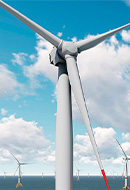
Benchmarks for our energy model
We face the challenges of climate change.

'Electricity for all' programme
We bring electricity to people who do not have access to this energy source.
The importance of electricity grids in history
Electricity is quite a complex product: it is generated, distributed through the grid and sold to the end user. This is why the grid is so important: it must be made up of a flexible system with various sources of generation.
Solar power plants and wind turbines produce no electricity during a summer night with no wind. In addition, during periods of drought, the use of water for the generation of electricity will be limited. If homes turn on their air-conditioning systems and generate a demand peak, the use of thermal power plants must be intensified or additional power must be purchased from neighbouring countries. The grid and its managers must be prepared to cater for the demand with the necessary resources.
In this context, the smart grids have emerged as a revolutionary solution that has changed the way electricity is produced, managed and consumed in recent times. This type of electricity grid can smartly and dynamically integrate renewable installations of various sizes. This also means that today, thanks to its bidirectional nature, the user can be both a consumer and a producer of electricity, by producing energy and selling it to industrial or commercial users.
The future of the electricity system
Today's society is undergoing a significant transformation in the way we conceive and consume electricity. Issues such as growing environmental awareness, the need to address climate change and advancing innovation are accelerating the transition towards a cleaner and more sustainable electricity. In this regard, the trends that will shape the future of the electricity sector are the following:
 Renewable generation
Renewable generation
The massive adoption of renewable energy sources, such as solar and wind, is transforming countries' energy mix. Distributed generation and small-scale installations will become increasingly accessible.
 Intelligent infrastructure
Intelligent infrastructure
The implementation of smart grids is essential to efficiently manage the complexity of a grid powered by renewable energies. Technologies such as artificial intelligence and energy storage will enable dynamic management of supply and demand, optimising grid efficiency.
 Consumer participation
Consumer participation
The transition to green electricity involves not only changes in generation, but also a transformation in the way consumers interact with energy. Environmental awareness encourages users to adopt more sustainable consumption practices – with the aim of achieving energy efficiency.
 Technological innovation
Technological innovation
Continued progress in storage technologies and research on new renewable sources promise more efficient and affordable solutions. The innovation technology will continue to drive the transition to cleaner electricity – opening new avenues for the deployment of sustainable solutions.





